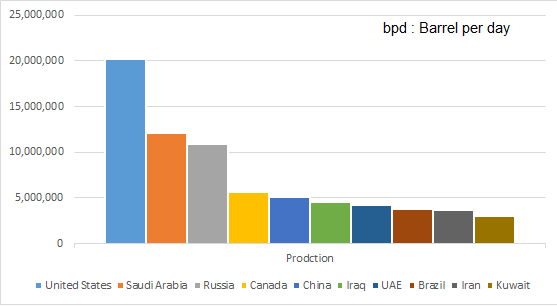Here’s a look at the top 10 oil producing countries.
Global oil production has continued to rise over the years. Price conflicts between oil-producing countries, Russia’s war in Ukraine, and COVID-19 interruptions have all had a major impact on the world oil market in recent years.
In 2021, demand for oil increased as COVID-19 lockdowns loosened globally, driving up prices. And the following year, as Russia’s aggressive campaign against Ukraine began, oil prices shot through the roof.
But in 2023, oil prices have been affected by a slowdown in economic activity brought on by rising interest rates and recessionary fears. OPEC members decided in June to extend a wider agreement to limit supply until 2024 and to drastically reduce output in July.
Apart from that, observers of the oil market are searching for clues that the Israel-Hamas conflict could extend to other Middle Eastern countries that produce oil. Slowing demand estimates for China and the possibility of Venezuelan oil output returning to the market have allayed these supply worries.
Given these and other recent market events, many investors are curious to know which countries produce the most oil. Statistics are from the Energy Information Administration (EIA) and include total production of petroleum and other liquids.

1. United States
Production: 20,213,000 bpd
The United States of America is ranked first among the top 10 nations that produce oil. In 2022, its output reached 20,213,000 bpd, up 1,232,000 bpd from 2021 levels. The United States has been referred to as a swing producer due to its production varying in tandem with market pricing. With output almost four times higher than that of New Mexico, the second-largest oil-producing state in the US, Texas leads the way.
US is a big consumer of oil. In 2022, the US consumed an average of 19.1 million barrels per day of petroleum products.
2. Saudi Arabia
Production: 12,144,000 bpd
In 2022, Saudi Arabia produced 12,144,000 barrels of oil per day. With 17 percent of the world’s proven petroleum reserves, the nation leads the world in petroleum exports. Approximately 50% of its GDP and 85% of its export revenue come from the oil and gas industry.
As mentioned, Saudi Arabia played a key role in OPEC’s decision to curb oil output back in 2020, as well as in 2023.
3. Russia
Production: 10,938,000 bpd
Prior to production cuts in 2020, Russian oil output had spent a number of years rising; it came in at 10,938,000 bpd in 2022. Most of Russia’s reserves are located in West Siberia, between the Ural Mountains and the Central Siberian Plateau, as well as in the Urals-Volga region, extending into the Caspian Sea.
As the third largest oil producer, Russia accounts for 10 percent of global output. In response to Russia’s war in Ukraine, Canada, US, UK and Australia have banned imports of Russian oil, representing about 13 percent of Russia’s exports.
In March 2022, the International Energy Agency (IEA) warned that Russia could be forced to cut 30 percent of its crude oil production, resulting in a serious global oil supply crisis. However, it seems that in 2023 Russia’s oil exports have rebounded to pre-war levels, with heavy demand from China and India.
4. Canada
Production: 5,694,000 bpd
Next on this list of the top 10 oil-producing nations is Canada. The country’s annual oil production rose to 5,694,000 bpd in 2022, up from 2021’s output amount of 5,537,000 bpd.
Nearly all of Canada’s proven oil reserves are located in Alberta, and according to the province’s government, 97 percent of oil reserves there are in the form of oil sands. Energy exports to the US account for the vast majority of Canada’s total energy exports.
5. China
Production: 5,119,000 bpd
China’s annual oil output was 5,119,000 bpd in 2022. The nation is the world’s second largest consumer of oil and moved from being the second largest net importer of oil to the largest in 2014.
China is the world’s most populous country and has a rapidly growing economy, factors that have driven its high overall energy demand. In fact, the Asian country is the top consumer of oil, with 55 percent of its imports coming from OPEC member countries. Unsurprisingly, Chinese demand can strongly influence the oil market.
6. Iraq
Production: 4,553,000 bpd
In 2017, despite increasing its output, Iraq got bumped from its position as the sixth largest oil-producing country. Output in 2018 helped the Middle Eastern nation regain its sixth spot position.
The country has seen its oil production decrease significantly in recent years, falling from 4,788,000 bpd in 2019 to 4,149,000 bpd in 2021. However, Iraq managed to increase its oil production in 2022 by 404,000 bpd over the previous year to total 4,553,000 bpd.
7. United Arab Emirates
Production: 4,237,000 bpd
The United Arab Emirates is an OPEC member. In 2022, it saw a significant year-on-year increase in production of 451,000 bpd, with oil output rising to 4,237,000 bpd.
The country holds the world’s eighth largest proven oil reserves at 98 billion barrels, with most of those reserves located in Abu Dhabi. The United Arab Emirates accounts for 5.6 percent of global total reserves.
8. Brazil
Production: 3,803,000 bpd
Brazil’s oil production rose slightly from 3,689,000 bpd in 2021 to 3,803,000 bpd in 2022. According to the EIA, total primary energy consumption in Brazil has nearly doubled in the past decade due to sustained economic growth. The largest share of Brazil’s total energy consumption is oil and other liquid fuels, followed by hydroelectricity and natural gas.
9. Iran
Production: 3,661,000 bpd
Iran’s oil output increased dramatically from 2,990,000 bpd in 2020 to 3,661,000 bpd in 2022. According to the EIA, Iran holds the world’s third largest proven oil reserves, as well as the world’s second largest natural gas reserves. Despite its abundant reserves, Iran’s oil production is still far below the 4,779,000 bpd produced back in 2017.
US sanctions and regional disputes have all weighed on Iran’s energy production sector. In 2021, China signed a 25 year trade and security agreement with Iran, and has called on the US to drop its sanctions.
10. Kuwait
Production: 3,022,000 bpd
Kuwait’s output increased from its 2021 level. After dropping to 2,717,000 bpd in 2021, the nation’s oil production has nearly rebounded to its 2018 levels. That year, production came in at 3,059,000 bpd.
Kuwait’s oil and gas sector accounts for about 60 percent of the country’s GDP.
FAQs related to oil
What is crude oil?
The liquid hydrocarbon deposits and other organic components that make up crude oil are found in underground reservoirs and are a naturally occurring mixture. This unprocessed natural resource is traded on the spot market and through derivatives contracts, making it an internationally significant commodity.
What is crude oil used for?
Once extracted from the Earth, crude oil is refined to make several products, including gasoline, jet fuel and other petroleum products such as kerosene, paraffin, petrochemical feedstocks, solvents and lubricants.
What country uses the most oil?
The US is by far the world’s largest oil consumer, using about the same amount of the fossil fuel as the next three largest oil consumers (China, India and Japan) combined.
How many years of oil are left?
The question of peak oil is a prominent one. However, it is difficult to correctly determine the exact amount of oil left to be extracted in the world, or to accurately predict the level of demand for the energy fuel over the coming years. New technologies may yet unlock future resources, or economic events may lead to serious shocks in demand.
That being said, based on current known reserve estimates and best-case demand scenarios, roughly 47 years of oil are currently thought to be left.
What is OPEC?
Founded in 1960, OPEC, or the Organization of the Petroleum Exporting Countries, is a group of 13 countries headquartered in Vienna, Austria. Led by Saudi Arabia, it controls production, supply and pricing in the global petroleum market.
Where does the US get its oil?
The US is the top producer of oil, but the country requires foreign imports to meet its increasing domestic demand.
According to the IEA, the nation sources oil from as many as 80 countries around the globe. The top five are Canada, Mexico, Russia, Saudi Arabia and Colombia.
How much oil does the US have in reserve in 2023?
As of 2023, the US had the ninth largest oil reserves in the world at 68.8 billion barrels.
Who uses the most oil in Europe?
Germany is the largest oil-consuming nation in Europe, and the 10th largest in the world. Despite its seemingly strong stance on climate action.
Why Venezuela can’t produce oil?
Venezuela’s oil industry has been suffering under the weight of political instability, government corruption and Trump-era US sanctions. Their inability to raise large capital required to rebuild energy infrastructure have also impacted production.
However, Venezuela’s oil production saw a rebound in 2023’s fourth quarter as the Biden administration eased US sanctions on the promise of fair elections in 2024.
How much oil does the US have in reserve in 2023?
As of 2023, the US had the ninth largest oil reserves in the world at 68.8 billion barrels.

